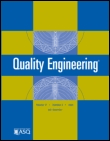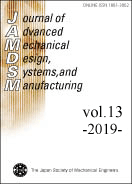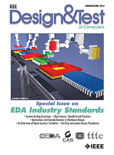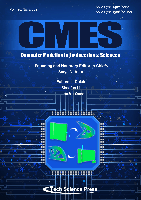
JOURNAL OF MECHANICAL DESIGN
Scope & Guideline
Advancing the Frontiers of Mechanical Design.
Introduction
Aims and Scopes
- Innovative Design Methodologies:
Focus on novel design approaches that leverage computational techniques, optimization algorithms, and data-driven strategies to enhance mechanical design processes. - Multidisciplinary Design Optimization:
Integration of various engineering disciplines to optimize complex systems, including mechanical, electrical, and materials engineering, to achieve robust solutions. - Human-Centered Design:
Exploration of user experience and interaction in design processes, emphasizing the importance of understanding user needs and preferences in engineering design. - Sustainability and Environmental Impact:
Research addressing the sustainability of design practices, including lifecycle assessment, remanufacturing, and environmentally friendly materials. - Advanced Manufacturing Techniques:
Investigation of innovative manufacturing processes, such as additive manufacturing, and their implications for design, including constraints and opportunities. - Modeling and Simulation:
Development of models and simulations to predict performance, reliability, and efficiency in mechanical systems, aiding in the design decision-making process. - Artificial Intelligence and Machine Learning Applications:
Utilization of AI and machine learning techniques to enhance design processes, including optimization, predictive modeling, and decision support. - Robustness and Reliability in Design:
Focus on ensuring the reliability and robustness of designs under varying conditions, incorporating uncertainty analysis and risk assessment.
Trending and Emerging
- Data-Driven Design Approaches:
An increasing number of studies focus on leveraging big data and machine learning for design optimization, reflecting the growing importance of data in engineering decision-making. - Sustainable Design Practices:
Research emphasizing sustainability, including eco-design and lifecycle analysis, is on the rise, indicating a strong commitment to addressing environmental concerns in engineering. - Human-Robot Collaboration:
A notable trend involves exploring the interaction between human designers and robots, particularly in collaborative design environments, highlighting the role of automation in design processes. - Generative Design and Topology Optimization:
The popularity of generative design techniques, particularly using artificial intelligence and advanced algorithms, is rapidly increasing, showcasing innovative ways to achieve optimal designs. - Interdisciplinary Design Integration:
There is a growing emphasis on interdisciplinary approaches that combine mechanical design with other fields such as biology, computer science, and social sciences to create holistic design solutions. - Resilience and Adaptability in Design:
Research focusing on designing for resilience and adaptability in complex systems is emerging, reflecting the need for designs that can withstand changing conditions and uncertainties. - Advanced Materials and Manufacturing Technologies:
The exploration of new materials and advanced manufacturing technologies, such as 3D printing and biomaterials, is increasingly prevalent, indicating a shift towards innovative production methods.
Declining or Waning
- Traditional Mechanical Design Methods:
There appears to be a decreasing emphasis on conventional mechanical design methodologies, as researchers increasingly adopt advanced computational techniques and data-driven approaches. - Overly Specialized Mechanical Systems:
Research focusing on niche mechanical systems with limited applicability has been declining, as there is a growing preference for studies addressing broader, multidisciplinary challenges. - Static Design Analysis:
The focus on static analysis of mechanical systems is waning in favor of dynamic and time-dependent analyses that better reflect real-world applications and performance. - Isolated Design Case Studies:
There has been a noticeable reduction in the publication of isolated case studies that do not contribute to broader theoretical frameworks or practical applications. - Basic Material Properties Studies:
Research centered solely on basic material properties without integration into advanced design applications is becoming less common, as the field moves toward more applied research.
Similar Journals

Journal of Control Automation and Electrical Systems
Advancing Innovation in Control and AutomationThe Journal of Control Automation and Electrical Systems, published by SPRINGER, is a prominent academic journal dedicated to advancing research in the interdisciplinary fields of control systems, automation, and electrical engineering. With an ISSN of 2195-3880 and E-ISSN of 2195-3899, this journal has emerged as a vital platform for disseminating high-quality research, contributing significantly to both theoretical and applied aspects of these interrelated domains. As of 2023, it ranks in the Q2 and Q3 quartiles across multiple categories, including Electrical and Electronic Engineering and Energy Engineering, showcasing its relevance and impact in the field. Although not an open-access journal, it provides rich access options for research works, ensuring that findings reach a wide audience. Researchers, professionals, and students alike can draw valuable insights from its curated articles that explore emerging trends, innovative technologies, and practical applications, thus reinforcing its position as a key contributor to the advancement of control and automation systems.

JOURNAL OF TURBOMACHINERY-TRANSACTIONS OF THE ASME
Leading the Charge in Turbomachinery Research and DevelopmentJOURNAL OF TURBOMACHINERY-TRANSACTIONS OF THE ASME is a premier publication in the field of mechanical engineering, specifically focusing on the innovative aspects of turbomachinery. Published by the renowned American Society of Mechanical Engineers (ASME), this journal has established itself as a key resource for both researchers and professionals in the industry, featuring cutting-edge research, reviews, and technical papers. With an impressive impact factor and a 2023 ranking placing it in the top quartile (Q1) of mechanical engineering journals, the Journal of Turbomachinery is dedicated to advancing the understanding of fluid dynamics, thermodynamics, and mechanical design as they pertain to turbomachinery applications. The journal's broad scope, covering everything from fundamental research to practical applications, is designed to foster innovation and encourage collaboration in this vital area of engineering. While the journal operates under a subscription model, its impact on the community is substantial, making it an essential read for anyone involved in mechanical engineering research or practice.

Quality Engineering
Fostering groundbreaking methodologies for quality enhancement.Quality Engineering, published by Taylor & Francis Inc, is a leading journal in the field of Industrial and Manufacturing Engineering and Safety, Risk, Reliability, and Quality. With a focus on the advancement of quality assurance and management practices, this journal has been a valuable resource since its inception, featuring research that spans from 1970 to the present day. The journal holds a commendable placement in the 2023 category quartiles, ranked Q2 in both relevant fields, highlighting its significance in contributing to innovative methodologies and solutions in quality engineering. Although currently not an open access publication, it continues to attract a wide array of contributions from researchers, professionals, and students dedicated to enhancing quality in engineering processes. With a Scopus rank reflecting its solid standing—75th percentile in Safety, Risk, Reliability and Quality and 62nd percentile in Industrial and Manufacturing Engineering—Quality Engineering remains an essential platform for disseminating knowledge that fosters excellence in the engineering domain.

Machines
Connecting researchers to foster collaboration and innovation.Machines is a leading journal in the fields of engineering and computer science, published by MDPI in Switzerland since 2013. As an Open Access publication, it ensures that researchers, professionals, and students can freely access high-quality peer-reviewed research. The journal covers a diverse range of topics, including control and optimization, mechanical engineering, electrical engineering, and industrial manufacturing, boasting impressive rankings in various Scopus categories, such as Q2 in Computer Science and Control Systems Engineering. With a commitment to advancing knowledge and innovation in these critical areas, Machines serves as an essential platform for disseminating research findings and fostering collaboration within the academic community. By contributing to the ongoing dialogue in these dynamic fields, the journal plays a pivotal role in shaping the future of technology and engineering practices.

Journal of Computational Design and Engineering
Leading the Charge in Computational Design and EngineeringThe Journal of Computational Design and Engineering, published by Oxford University Press, is a premier open-access journal dedicated to advancing the field of computational science, technology, and engineering. With an E-ISSN of 2288-5048 and having transitioned to open access in 2015, this journal fosters a wide-reaching dissemination of high-quality research and innovative methodologies pertinent to computational mathematics, mechanics, modeling, and simulation. Notably recognized within the academic community, the journal boasts impressive rankings, including Q1 in Computational Mechanics and Computer Graphics, underscoring its significance in these fields. With a broad scope that appeals to researchers, professionals, and students alike, the Journal of Computational Design and Engineering plays a vital role in stimulating discussions on the intersection of computation and design, providing a platform for the latest advancements that shape engineering practices globally. As we look forward to its continued publication until 2024, the journal stands as a crucial resource for those aiming to push the boundaries of knowledge in computational engineering disciplines.

Journal of Advanced Mechanical Design Systems and Manufacturing
Advancing Knowledge through Open Access Research.The Journal of Advanced Mechanical Design Systems and Manufacturing, published by the Japan Society of Mechanical Engineers, is a pivotal scholarly platform dedicated to advancing knowledge in the fields of Industrial and Manufacturing Engineering and Mechanical Engineering. As an Open Access journal since 2021, it provides unrestricted access to high-quality research, facilitating broader dissemination and collaboration among researchers, professionals, and students globally. The journal's emphasis on innovative methodologies and cutting-edge technologies contributes significantly to the evolving landscape of engineering practices, with its research scope encompassing the latest advancements and applications in mechanical design and manufacturing systems. With a current impact factor that positions it in the Q3 quartile of both the Industrial and Manufacturing Engineering and Mechanical Engineering categories, along with its Scopus rankings further indicating its relevance in the field, this journal is an essential resource for those seeking to push the boundaries of mechanical engineering knowledge. For further inquiries or submissions, please reach the journal at its headquarters located at KDX Iidabashi Square Bldg, 2nd Floor, 4-1 Shin-ogawamachi, Shinjuku-ku, Tokyo, Japan.

Australian Journal of Mechanical Engineering
Elevating Industry Standards through Rigorous Research and Insight.The Australian Journal of Mechanical Engineering is a distinguished publication in the realm of mechanical engineering, dedicated to advancing the knowledge and application of engineering principles within the industry. Published by TAYLOR & FRANCIS LTD in the United Kingdom, this journal has been integral to the field since its inception, featuring a range of peer-reviewed research articles, reviews, and technical notes that collectively aim to bridge theoretical research with practical applications. With an impressive Scopus ranking of #271 out of 672 in Mechanical Engineering, positioning it within the 59th percentile, the journal continues to uphold rigorous academic standards, currently occupying Q3 in the 2023 quartile rankings. Researchers, professionals, and students alike will benefit from its comprehensive coverage and insightful contributions, providing a vital platform for knowledge exchange and innovation in mechanical engineering.

IEEE Design & Test
Fostering Collaboration for Technological AdvancementsIEEE Design & Test is a leading academic journal published by the IEEE-INST ELECTRICAL ELECTRONICS ENGINEERS INC, dedicated to advancing the fields of Electrical and Electronic Engineering, Hardware and Architecture, and Software. With an ISSN of 2168-2356 and an E-ISSN of 2168-2364, the journal spans from 2013 to 2024, offering valuable insights and peer-reviewed research that addresses critical challenges in the design, verification, and testing of electronic systems. Recognized for its quality, the journal holds a Q2 designation in Electrical and Electronic Engineering and ranks within the top quartiles of its category, making it a notable resource for professionals and scholars alike. Its Scopus rankings, particularly a rank of #354 in Electrical and Electronic Engineering, underscores its significance and relevance in the rapidly evolving technological landscape. Although not currently open access, the journal remains committed to disseminating innovative research that shapes the future of technology, ensuring that researchers and practitioners stay at the forefront of their disciplines. IEEE Design & Test serves as an essential platform for exchanging ideas, fostering collaboration, and driving advancements in engineering and computer science.

CMES-COMPUTER MODELING IN ENGINEERING & SCIENCES
Advancing Computational Frontiers in Engineering & SciencesCMES-COMPUTER MODELING IN ENGINEERING & SCIENCES is a premier journal published by Tech Science Press, dedicated to advancing knowledge in the fields of computer science applications, modeling and simulation, and software engineering. With an impressive convergence of research from 2000 to 2024, this journal stands out as a vital resource for researchers, professionals, and students alike, fostering innovation and collaboration in computational methodologies. The journal currently holds a Q3 category ranking in multiple disciplines according to the latest metrics, including Scopus, which reflects its growing significance in the academic community. By providing a platform for high-quality research and open discourse, CMES aims to enhance the understanding of complex systems through effective modeling techniques and computational tools. Despite its current classification under open access, the journal remains a cornerstone for those looking to deepen their expertise in cutting-edge computational engineering and science.

MANUFACTURING ENGINEERING
Shaping the Landscape of Manufacturing KnowledgeManufacturing Engineering is a pivotal journal specializing in the fields of Industrial and Manufacturing Engineering, as well as Mechanical Engineering, with a rich history of publication since its inception in 1975. Published by the esteemed Société des Ingénieurs de Fabrication (SME), this journal plays a crucial role in disseminating innovative research, practical applications, and emerging technologies that shape the manufacturing sector. Despite its recent positioning in the Q4 quartile rankings on Scopus, the journal serves as a platform for rigorous peer-reviewed articles that contribute to the academic dialogue and bolster advancements in manufacturing practices. The journal operates without open access options, making it an essential resource for institutions and professionals looking to stay informed within the manufacturing domain. With a dedicated audience comprising researchers, engineers, and industry professionals, Manufacturing Engineering continues to address the evolving challenges and opportunities in manufacturing, fostering an environment ripe for collaboration and exploration.